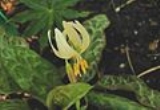
Erythronium citrinum
Encyclopedia
Erythronium citrinum, also known as citrus fawn lily or cream fawn lily, is a member of the lily family
that is found in southwest Oregon
and adjacent northwest California
. The genus Erythronium
, which can be found across northern North America, Europe and Asia, is most diverse in California, which is home to fifteen of about twenty-eight members of the genus.
Its flowers are borne on stems that are six to eight inches tall. It has a pair of broad mottled leaves up to about six inches long. The stigma
is very shallowly three lobed, and its anthers
are white. It grows in open woods and shrubby slopes, and is more or less confined to serpentine soil
s. It blooms in early spring and can sometimes be seen blooming in profusion.
It grows in the vicinity of E. oregonum
, E. howellii, and E. hendersonii
. The flower of cream fawn lily is creamy-white with a yellow center. The tips of the tepal
s turn pinkish as they age. The very similar E. howellii is more restricted in its range and can be distinguished by its lacking of nectariferous appendages on the bases of the inner petals. E. hendersonii, which has a distribution that ends just at the northern boundary of the cream fawn lily, is fairly similar, but is easily distinguished by its purple flowers. E. oregonum, which is wide ranging and fairly abundant in southwest Oregon can be distinguished by its deeply divided three-lobed stigma (whereas E. citrinum is narrowly divided).
Liliaceae
The Liliaceae, or the lily family, is a family of monocotyledons in the order Liliales. Plants in this family have linear leaves, mostly with parallel veins but with several having net venation , and flower arranged in threes. Several have bulbs, while others have rhizomes...
that is found in southwest Oregon
Oregon
Oregon is a state in the Pacific Northwest region of the United States. It is located on the Pacific coast, with Washington to the north, California to the south, Nevada on the southeast and Idaho to the east. The Columbia and Snake rivers delineate much of Oregon's northern and eastern...
and adjacent northwest California
California
California is a state located on the West Coast of the United States. It is by far the most populous U.S. state, and the third-largest by land area...
. The genus Erythronium
Erythronium
Erythronium is a genus of 20-30 species of spring-flowering perennial plants with long, tooth-like bulbs and attractive pendant flowers, native to forest and meadow in temperate regions of the Northern Hemisphere.-Species:-Uses:The bulb is edible as a root vegetable, cooked or dried, and can be...
, which can be found across northern North America, Europe and Asia, is most diverse in California, which is home to fifteen of about twenty-eight members of the genus.
Its flowers are borne on stems that are six to eight inches tall. It has a pair of broad mottled leaves up to about six inches long. The stigma
Gynoecium
Gynoecium is most commonly used as a collective term for all carpels in a flower. A carpel is the ovule and seed producing reproductive organ in flowering plants. Carpels are derived from ovule-bearing leaves which evolved to form a closed structure containing the ovules...
is very shallowly three lobed, and its anthers
Stamen
The stamen is the pollen producing reproductive organ of a flower...
are white. It grows in open woods and shrubby slopes, and is more or less confined to serpentine soil
Serpentine soil
A serpentine soil is derived from ultramafic rocks, in particular serpentinite, a rock formed by the hydration and metamorphic transformation of ultramafic rock from the Earth's mantle....
s. It blooms in early spring and can sometimes be seen blooming in profusion.
It grows in the vicinity of E. oregonum
Erythronium oregonum
Erythronium oregonum is a species of flowering plant in the lily family which is known by the common name giant white fawn lily.It is native to western North America from British Columbia to California, where it grows in the Pacific Coast Ranges....
, E. howellii, and E. hendersonii
Erythronium hendersonii
Erythronium hendersonii, Henderson's Fawn Lily, is a member of the Lily family that is endemic to southwest Oregon, and barely reaching into Northern California...
. The flower of cream fawn lily is creamy-white with a yellow center. The tips of the tepal
Tepal
Tepals are elements of the perianth, or outer part of a flower, which include the petals or sepals. The term tepal is more often applied specifically when all segments of the perianth are of similar shape and color, or undifferentiated, which is called perigone...
s turn pinkish as they age. The very similar E. howellii is more restricted in its range and can be distinguished by its lacking of nectariferous appendages on the bases of the inner petals. E. hendersonii, which has a distribution that ends just at the northern boundary of the cream fawn lily, is fairly similar, but is easily distinguished by its purple flowers. E. oregonum, which is wide ranging and fairly abundant in southwest Oregon can be distinguished by its deeply divided three-lobed stigma (whereas E. citrinum is narrowly divided).

